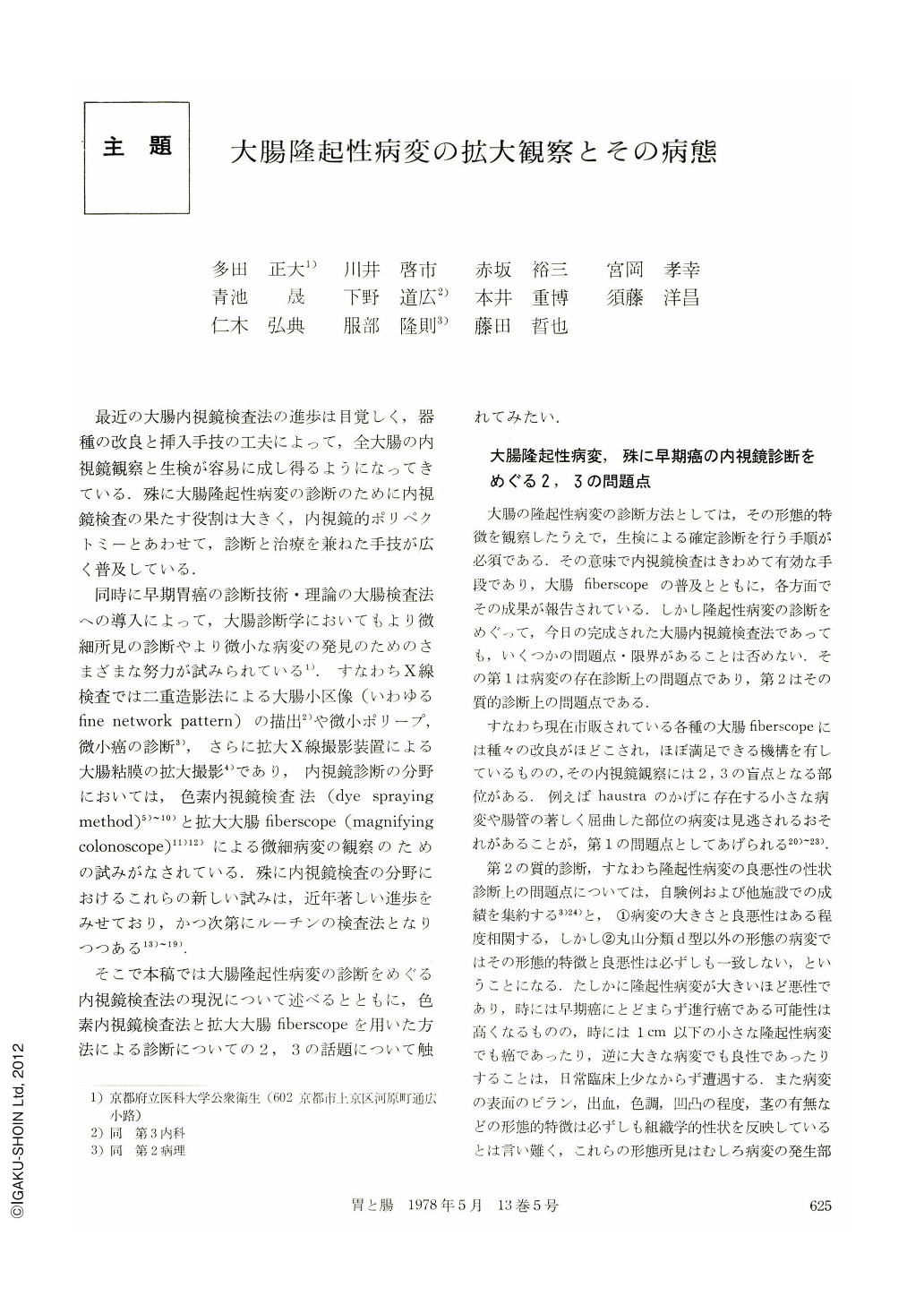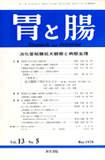Japanese
English
- 有料閲覧
- Abstract 文献概要
- 1ページ目 Look Inside
- サイト内被引用 Cited by
最近の大腸内視鏡検査法の進歩は目覚しく,器種の改良と挿入手技の工夫によって,全大腸の内視鏡観察と生検が容易に成し得るようになってきている.殊に大腸隆起性病変の診断のために内視鏡検査の果たす役割は大きく,内視鏡的ポリペクトミーとあわせて,診断と治療を兼ねた手技が広く普及している.
同時に早期胃癌の診断技術・理論の大腸検査法への導入によって,大腸診断学においてもより微細所見の診断やより微小な病変の発見のためのさまざまな努力が試みられている1).すなわちX線検査では二重造影法による大腸小区像(いわゆるfine network pattern)の描出2)や微小ポリープ,微小癌の診断3),さらに拡大X線撮影装置による大腸粘膜の拡大撮影4)であり,内視鏡診断の分野においては,色素内視鏡検査法(dye spraying method)5)~10)と拡大大腸fiberscope(magnifying colonoscope)11)12)による微細病変の観察のための試みがなされている.殊に内視鏡検査の分野におけるこれらの新しい試みは,近年著しい進歩をみせており,かつ次第にルーチンの検査法となりつつある13)~19).
Recently, remarkable advance in fiberoptics and vigorous efforts to observe the whole colon has made it much easier to insert endoscope into the ileocecal area. It is no exaggeration to say that almost all lesions of the colon and terminal ileum can be diagnosed by endoscopy. One of our recent interests in colonoscopy is how to diagnose minute lesions correctly. For this purpose, several new methods have been attempted in our clinic. One of them is a dye spraying method and another is a close-up observation with the use of the magnifying colonoscope.
Using the dye spraying method, the mucosal surface was seen as a fine network pattern, not observed by conventional colonoscopy. Small polypoid lesions could be easily differentiated by this method. For the second method, a newly devised magnifying colonoscope, type CF-MB-M (Olympus), was developed. The optical system of CF-MB-M is different from that of CF-MB, which is marketed. The forcusing system of CF-MB is fixed, whereas that of CF-MB-M is adjustable. Therefore, we can have not only the conventional view (distant view) but also the close-up view (magnified observation) by using the CF-MB-M. Its close-up observation enables us to magnify the mucosa about 10~25 times larger than the CF-MB.
Minute structures of polypoid lesions were clearly observed through the combination of the CF-MB-M and methylene blue dye spraying method. Staining the lesions and magnifying them about 10~25 times larger, several types of structures of pits or sulcus, clearly similar to the observations by the dissecting microscope, were seen. These minute surface appearances were classified into six categories : circular, papillary, tubular, sulcus, mixed and irregular types. Most of metaplastic polyps were of circular and papillary types, adenomatous polyps were of tubular or sulcus and all of advanced cancer were of the irregular type. Therefore, differential diagnosis of these benign polyps and advanced cancer can always be diagnosed by this method. In our series, 67% of early cancers were of the irregular type, and were easily differentiated from benign polyps. But, 33% which were proved to have focal cancer revealed tubular or slucus types and showed the almost same appearance as the benign adenomatous polyps. Therefore, the diagnosis of early cancer or diminutive cancer still remains to be a problem and further improvements of both the magnifying capabilities of the scope and the dye spraying method will be necessary.
Nevertheless, by magnifying the mucosa in familiar polyposis coli, we were able to observe several enlarged minute pits, strongly supposed as “the bud of adenoma”

Copyright © 1978, Igaku-Shoin Ltd. All rights reserved.


